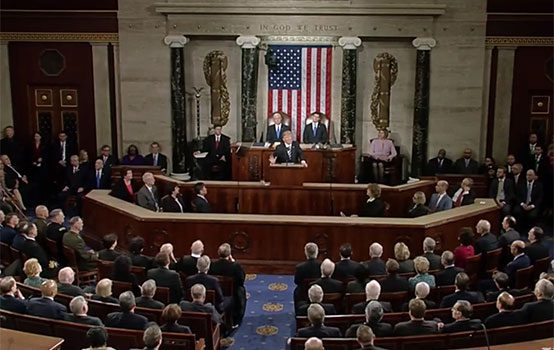Addressing Trump’s Errant Foreign Policy

Conservatives such as myself, who seek a return to America’s historic and successful foreign policy of non-intervention in overseas quarrels that are unrelated to American interests, thought we had won in November. In Donald Trump we had elected a non-interventionist president. He pledged good relations with Russia, avoidance of new wars, and, at least by inference, ending the conflicts he inherited, including the hopeless war in Afghanistan.
But that’s not how things turned out. On some issues, Trump has been true to his campaign. On his recent European trip, he refused to bow down and worship the great clay god NATO, which exists primarily to rekindle the Cold War with Russia. He pulled out of the globalist Paris Agreement. So far he has not signed off on the idiotic plan to send more troops to Afghanistan and resume “nation building” there.
But on a broader basis, the president has allowed his non-interventionist stance to be subverted by the Republican establishment. He has backed away from seeking an alliance with Russia. He has accepted continued deep American involvement in the Middle East. He has given the Pentagon more money, which, without military reform, just buys more expensive defeats. He has pursued strategically irrelevant quarrels with Iran and, dangerously, North Korea. This is not what “America First” looks like.
In the face of this disappointment, where are non-interventionist conservatives to find a voice? We can, of course, write articles for magazines, speak at conferences, and lament “O tempora! O mores!” over sherry at the club. But a rule of life in Washington is that unless you are connected to political power, no one reads what you write or listens to what you say. You don’t count.
There is a place non-intervention conservatives can turn to find a voice, and that is Capitol Hill. In the 1980s I was at the core of an anti-establishment effort that seriously rattled the Defense Department—the military reform movement. The movement became influential when it tied reformers’ ideas to a congressional power base, the Congressional Military Reform Caucus. This bipartisan caucus began when a conservative Republican member of the House Armed Services Committee, Congressman Bill Whitehurst, met with Democratic Senator Gary Hart, who served on the Senate Armed Services Committee, and said, “What do you think we could do for military reform if we put our efforts together?” (I was present at that meeting.) The result was a reform caucus that at one point counted over 100 members of Congress.
If non-intervention conservatives can create something similar to the Military Reform Caucus, they will have a voice. They will count in Washington. But times have changed. The extreme partisanship that now characterizes Capitol Hill makes the hope of a bipartisan caucus unrealistic. Members might fear encouraging a primary challenge if they joined one.
However, there is a way around this obstacle. Non-intervention conservatives should seek to create a Republican anti-intervention caucus. It should be called the “America First Caucus.” That would make it difficult for neoconservatives to label it “weak.” If President Trump decides against intervention in someone else’s quarrel, it would support him. If he goes with the interventionists, it would criticize and oppose him.
The president is not likely to be comfortable facing an opposition on Capitol Hill that calls itself the America First Caucus.
Just as the Military Reform Caucus did in its time, the America First Caucus would have a symbiotic relationship with other non-interventionists of various stripes. It would put articles they write in the Congressional Record. It would sponsor debates and discussions on Capitol Hill. It would use their work to support the caucus members’ legislative initiatives. In turn, non-interventionist thinkers and writers would contribute their efforts to promoting the caucus and its work in a wide variety of media.
Meanwhile, a similar effort likely would spring up on the left. Anti-intervention liberals would organize a Democratic caucus. Obviously, conservatives cannot do that for them. But the example set by the Republican caucus should inspire someone on the left to try to copy it among Democrats.
Then, on an issue-by-issue basis, the two caucuses could work together to curtail America’s intervention in the wars of other peoples. Despite the current high level of partisanship, that is still possible. A bipartisan effort is currently coming together on the Hill to block money from flowing from this country to terrorist organizations such as ISIS (yes, that happens). I learned long ago that one way—often the only way—to defeat the establishment is to sandwich it in a double envelopment from the right and left. It does not know how to deal with that, because it breaks the matter under consideration free of the usual trench warfare. My old colleague and political mentor Paul Weyrich understood this, which is why he sometimes worked in tandem with figures such as Ralph Nader. The establishment howled, but it howled because it was scared.
As the Military Reform Caucus did, the America First Caucus and its Democratic counterpart would probably both start small. But even a handful of members of Congress is sufficient to give change a voice. As the American people’s disgust grows over unnecessary and avoidable foreign wars—what many of them expressed in voting for Donald Trump—the two caucuses will also grow. Perhaps, in time, they might gain strength to the point that we could once again enjoy a bipartisan foreign policy where our country takes precedence over party.
William S. Lind is the author, with Lt. Col. Gregory A. Thiele, of the 4th Generation Warfare Handbook.
Comments